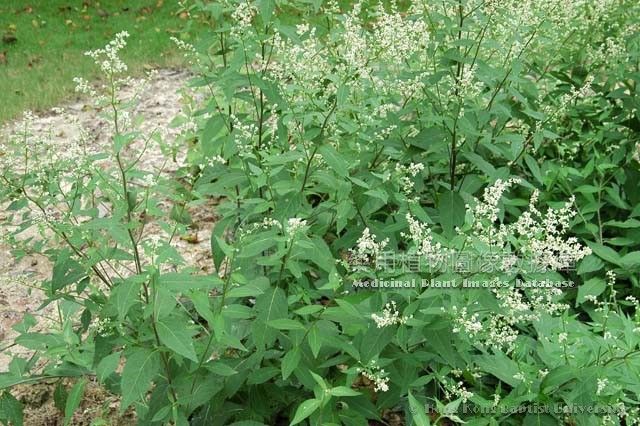|
Artemisia anomala S. Moore

|
English Name |
Diverse Sagebrush, Diverse Wormwood |
|
Latin name |
Artemisia anomala S. Moore |
|
Family & Genus |
Asteraceae, Artemisia |
|
Description |
Perennial herbs, 80-150cm tall. Erect stem, multi-branched above middle part, upper part with slightly pubescent inflorescence branches. Middle leaves nearly leathery, ovate-lanceolate or oblong, 7-11cm long, 3-4cm wide, apex acuminate, base gradually narrows to short stalk, non-dividing, margin with fine serration, light color below, gossamer-liked pubescence or glabrous, slightly coarse hairs above; pinnate veins 5-8 pairs. Capitulums no peduncles, extremely numerous, dense on flowering branches, together into long auxiliary racemes on top of stem and upper axil, up to 25cm; involucres glabrous, nearly campanulate, ca. 3mm long; involucral bracts oblong; 3-4 layers, margin wide, membranous; small flowers in capitulums arranged to tubular flowers, outside layer female, inside bisexual; 5 synantherous stamens, 1 pistil. Achenes, fine, glabrous, oblong. Flowering: July to September; fruiting: September to November. |
|
Distribution |
Growing in forest edges, thickets, and on riverbanks. Widely distributed in the central and southern parts of China. Mainly produced in Jiangsu, Zhejiang, Jiangxi and etc. |
|
Part Used |
Medical part: entire plant with flowers. Chinese name: Liujinu. |
|
Harvest & Processing |
Collected when flowering in July to September, excavated with root, well washed, used fresh or sun-dried, bundled up for standby application. |
|
Chemistry |
Contains flavonoids, such as arteanoflavone, galuteolin and apigentrin, etc., coumarins, such as comarin, herniarin, etc., terpenpids, organic acids and volatile oils, etc. |
|
Pharmacology |
Anti-anoxia, blood-activating and stasis-dissipating. |
|
Properties & Actions |
Pungent, little bitter, warm.Dissipating stasis, stimulating meridians, arresting bleeding, dispersing swelling, benefiting digestion and removing accumulation. |
|
Indications & Usage |
Menostasia, promoting menstrual flow, postpartum abdominal pain due to blood stasis, persistent lochia, abdominal mass, injuries from falls, blood loss from bleeding wounds, rheumatic arthralgia, hemafecia, hematuria, anthracia and swelling toxicity, scalding injuries, dyspeptic abdominalgia, diarrhea and dysentery.Internal: decocting, 5-10g; for digestion 15-30g; or powdered. External: appropriate amount, triturated for application; or powdered for application. |
|
Examples |
1. Distension of blood and Qi: herba artemisiae spike and seeds into powder. Take 3 qian each time, decoct in alcohol and drink.
2. Trauma by hitting and blood stasis in abdomen: herba artemisiae, corydalis tuber, rhizoma drynariae 1 liang each, cut into pieces, decoct in 3L water for 7 times, and mix, warm up and drink.
3. Dysentery: herba artemisiae, Chinese magnoliavine fruit in equal amounts, grind into a fine powder. Swallow with alcohol under fasting state. Apply powder, and the patient is cured. |
| Link to |
 Chinese Medicine Specimen Database Chinese Medicine Specimen Database
|
|

